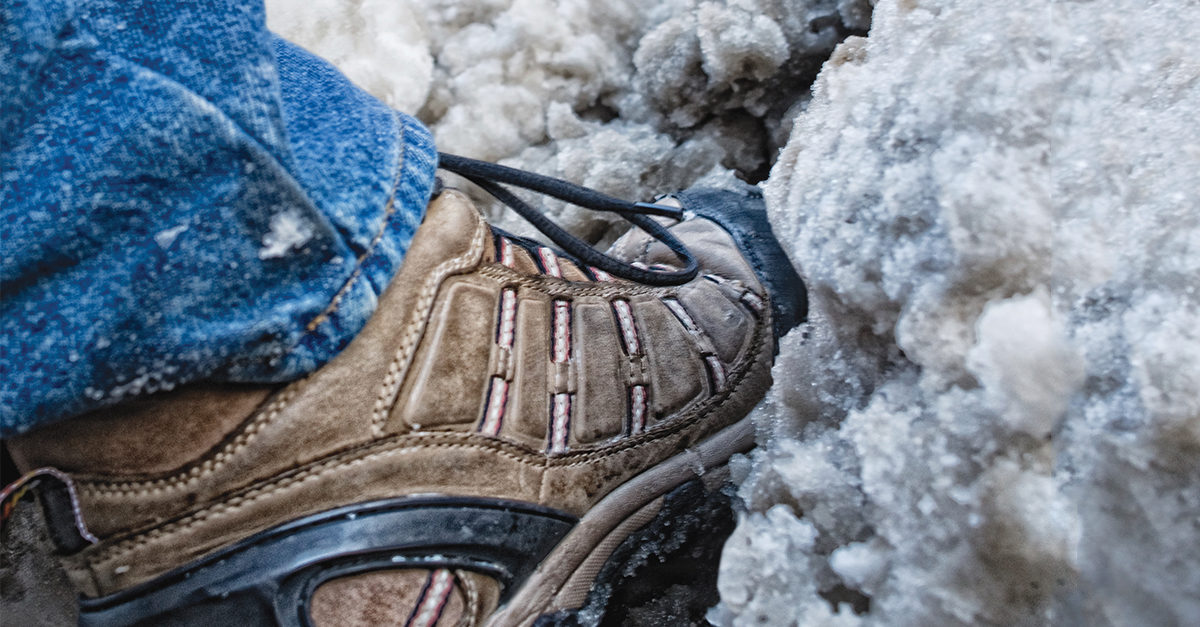Taking care of carpet the right way has a direct impact on the overall appearance of an entire building; however, it also does so much more. Proper carpet care is the single most important factor in determining a carpet’s durability and longevity. It can also significantly improve indoor air quality.
But during long winter months, especially in regions where snow can sometimes appear well into the spring, the job becomes challenging. A comprehensive carpet-care strategy that targets salt and focuses on prevention will help your building to be a cleaner, healthier environment all year round.
The Winter Challenge
Even with the best preventive measures in place, the elements always seem to find their way inside. In fact, about 80 percent of the soil present on carpets has been tracked in from the outside. And during winter, the worst culprit is salt. “I like to call it managing salt intrusion,” says Mark Violand, certified instructor and inspector by the Institute of Inspection, Cleaning and Restoration Certification (IICRC). “During the winter in Northeast Ohio, people are literally walking on salt and don’t even touch the pavement. And that’s an issue to keep it out of the building. You maintain it. You’re never going to get rid of the salt completely during the winter.”
Most experts agree that successful carpet-care programs should include preventive, daily, interim, and restorative cleaning processes. During the winter months, you’ll want to up your preventive, daily, and interim efforts to avoid costly restorative efforts later on down the line.
Preventive Cleaning
Preventive cleaning means keeping as much soil as possible out of your building and off of your carpet. Sweeping the sidewalk and outside of the entryway is a great first line of defense.
Next, you’ll want to focus your efforts on matting. Professionals and organizations throughout the industry seem to agree that mats can trap somewhere between 80 to 90 percent of the soil that is tracked into a building. A rule of thumb is to make sure at least 15 feet of matting is present at all entrances, exits, service ways, and side doors of a building. “It’s a good idea to invest in extra walk-off mats,” says Pat Jennings, director of standards and specifications at The Carpet and Rug Institute, Inc. “But be sure to clean them, because it doesn’t do carpet any good for people to wipe their feet off on dirty mats and then track the soil and moisture onto the carpet.”
According to Violand, the best preventive measures go beyond matting. He considers weekly hot-water extraction and daily vacuuming as part of a preventive cleaning program, too. This helps to minimize the possibility of tracking salt and soil into other areas of the building. “You can’t vacuum sludge; that’s going to destroy the vacuum,” Violand says. “My own service [professionals] use equipment with counter-rotating brushes and equipment that has a hopper on it, so it can collect the salt and debris that’s being picked up by the brushes.”
Daily Cleaning
Daily cleaning should include washing your mats, vacuuming, and spot removal. A daily carpet-care regimen doesn’t necessarily mean you do these things once a day. The procedures in this category can be performed more frequently throughout the day and night, sometimes as many as three times a day for walk-off mats in a high traffic area, Jennings says. “If you live in a region where there is a lot of snow and ice, it’s good to trade out the mats during the day.”
In addition to soil and salt, carpet could be harboring bacteria, mold, dust mites, pollen, and other allergens. This is where vacuuming becomes even more crucial, especially during the winter flu and cold season. A vacuum with a high efficiency particulate air (HEPA) filter—one that traps tiny particles and doesn’t let them back out into the air—can positively impact the building’s indoor-air quality. In the winter, when more and more people are staying inside for longer and longer, vacuuming will make it easier for everyone to breathe. “Proper vacuuming is the single most important thing you can do to prolong the life of your carpet,” Violand stresses.
Violand also likes hot-water extractors as a form of periodic maintenance during the winter months. He recommends using salt-stain removers as a pre-treatment to help break down salt along with hot-water extraction once or twice a week to keep on top of salt intrusion.
“Daily maintenance should include spot removal with a good bottle of spot remover and some towels,” Violand advises. He recommends using an encapsulating spot remover. This means that the product will dry to a crisp, crystalline structure when it dries, making it easy to vacuum up any residue that is left on the carpet.
Interim Cleaning
One of the areas most frequently carpeted in a building is the lobby, so the first thing visitors see when they enter is the carpet. “It’s called public relations and marketing 101,” Violand says. One way to keep those carpets attractive for visitors is with a regular interim cleaning program.
Interim cleaning refers to the process of treating a carpet with dry or sprayed chemicals that are then agitated and picked up by a machine. Interim cleaning targets the top third of the carpet fibers and is focused on making the carpet look nice. The keys to successful interim cleaning include vacuuming before and after the treatment, using the proper dwell time for chemicals, and using machines with sufficient agitation. This method of cleaning is especially effective on oily substances, which includes the salt that is tracked in during the winter months.
Restorative Cleaning
Restorative cleaning, also known as deep extraction, removes entrapped soil from the very bottom of the carpet fibers. Because this process is often used with high moisture, it takes longer and requires time for drying. The process for deep extraction includes treating the carpet with water and detergent and agitating it with a machine, then letting it soak, extracting it, rinsing it, and repeating as necessary. After this is finished, the carpet must be left to dry completely. Interim and restorative cleaning are both components of a thorough carpet-care program—when they are used together, the results can be excellent.
Spring Cleaning
Even the coldest and longest winters eventually lead to springtime. When preparing your carpeting for the months ahead, focus on the outside first.
“How do you prepare for springtime?” Violand asks. “You get that sidewalk clean. Stop tracking that salt in.” In fact, during some years, Violand’s team was cleaning up salt residue well into June and July.
Spring might be the right time for you to schedule a deep extraction. “Spring cleaning is not just for homes, but businesses and facilities as well,” Jennings advises. “Spring can be the perfect time to have your carpet professionally cleaned so your carpet will look fresh and provide the service you expect.”
As we look ahead to spring, it’s important to focus on managing the current problems of winter. And that means taking a comprehensive approach to carpet care. Jennings offers these final words of advice: “Use walk-off mats on the inside and outside of entrances and exits; clean spots immediately when they occur; daily vacuuming, periodic deep cleanings, and interim maintenance are essential for proper care.”




